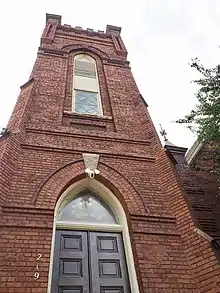Brooklyn (Charlotte, North Carolina)
Brooklyn was a largely African American section of Charlotte, North Carolina. It was home to many businesses, residences, and churches. The neighborhood was demolished for an urban renewal project in the 1960s[1][2] and is now part of what is known as the Second Ward.[3]

Originally known as Logtown, the area grew after the American Civil War as freed slaves settled in urban areas. It developed commerce, was home to fine residences of Charlotte's prosperous and prominent African Americans as well as shanties. It was home to Charlotte's first school for African Americans, the Myers Street School, which closed in 1907.[3] A new high school was built in 1923 called Charlotte Colored High School. It was Charlotte's only high school open to African American students and became known as Second Ward High School after a few years.[4] It closed in 1969 in the wake of integration as African American schools were closed across the South and the students were bussed to white schools. The Brooklyn area also had a YMCA, a library, the A.M.E. Zion Publishing House,[3] numerous churches, and the Queen City Drug Store. The area was razed in the 1960s and replaced by a government and commercial building project that forced out its residents.[3][5]
The Swank Social Club was established on the site of the former Second Ward High School.
The Levine Museum of the New South in Charlotte held an exhibit about the community in 2019.[6][2]A mixed use development called Brooklyn Village has been proposed in Charlotte.[7]
The Old Grace A.M.E. Zion Church is one of the few remaining buildings. Second Ward Gym has also been preserved and renovated.
Second Ward is also now home to Pearl Street Park and the Harvey B. Gantt Center for African-American Arts + Culture.
See also
References
- https://www.charlotteobserver.com/news/local/article224643350.html
- Carolina Impact Season 7 Episode 12 (YouTube)
- https://guides.library.uncc.edu/c.php?g=621704&p=4626874
- "The Charlotte-Mecklenburg Story: Second Ward High School". Charlotte-Mecklenburg Library.
- "Brooklyn Village: History". BrooklynVillageCLT.com. Retrieved January 8, 2021.
- ""Brooklyn: Once a City within a City" opens at Levine Museum on Nov. 15". Q City Metro. November 14, 2019.
- Tim Funk (January 18, 2019). "Brooklyn was the center of black life in Charlotte. Until the bulldozers arrived". The Charlotte Observer. Retrieved January 8, 2021.